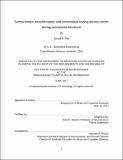| dc.contributor.advisor | Mriganka Sur. | en_US |
| dc.contributor.author | Pho, Gerald N. (Gerald Norman) | en_US |
| dc.contributor.other | Massachusetts Institute of Technology. Department of Brain and Cognitive Sciences. | en_US |
| dc.date.accessioned | 2018-03-02T21:39:12Z | |
| dc.date.available | 2018-03-02T21:39:12Z | |
| dc.date.issued | 2017 | en_US |
| dc.identifier.uri | http://hdl.handle.net/1721.1/113919 | |
| dc.description | Thesis: Ph. D. in Neuroscience, Massachusetts Institute of Technology, Department of Brain and Cognitive Sciences, 2017. | en_US |
| dc.description | This electronic version was submitted by the student author. The certified thesis is available in the Institute Archives and Special Collections. | en_US |
| dc.description | Cataloged from student-submitted PDF version of thesis. "June 2017." Page 206 blank. | en_US |
| dc.description | Includes bibliographical references. | en_US |
| dc.description.abstract | Perceptual decision-making is an important and experimentally tractable paradigm for uncovering general principles of neural information processing and cognitive function. While the process of mapping sensory stimuli onto motor actions may appear to be simple, its neural underpinnings are poorly understood. The goal of this thesis is to better understand the neural mechanisms underlying perceptual decision-making by exploring three major questions: How is decision-relevant information encoded across the cortex? What cortical areas are necessary for perceptual decision-making? And finally, what neural mechanisms underlie the mapping of sensory percepts to appropriate motor outputs? We investigated the roles of visual (V1), posterior parietal (PPC), and frontal motor (fMC) cortices of mice during a memory-guided visual decision task. Large-scale calcium imaging revealed that neurons in each area were heterogeneous and spanned all task epochs (stimulus, delay, response). However, information encoding was distinct across regions, with V1 encoding stimulus, fMC encoding choice, and PPC multiplexing the two variables. Optogenetic inhibition during behavior showed that all regions were necessary during the stimulus epoch, but only fMC was required during the delay and response epochs. Stimulus information was therefore rapidly transformed into behavioral choice, requiring V1, PPC, and fMC during the transformation period, but only fMC for maintaining the choice in memory prior to execution. We further investigated whether the role of PPC was specific to visual processing or to sensorimotor transformation. Using calcium imaging during both engaged behavior and passive viewing, we found that unlike V1 neurons, most PPC neurons responded exclusively during task performance, although a minority exhibited contrast-dependent visual responses. By re-training mice on a reversed task contingency, we discovered that neurons in PPC but not V1 reflected the new sensorimotor contingency. Population analyses additionally revealed that task-specific information was represented in a dynamic code in PPC but not in V1. The strong task dependence, heterogeneity, and dynamic coding of PPC activity point to a central role in sensorimotor transformation. By measuring and manipulating activity across multiple cortical regions, we have gained insight into how the cortex processes information during sensorimotor decisions, paving the way for future mechanistic studies using the mouse system. | en_US |
| dc.description.statementofresponsibility | by Gerald N. Pho. | en_US |
| dc.format.extent | 206 pages | en_US |
| dc.language.iso | eng | en_US |
| dc.publisher | Massachusetts Institute of Technology | en_US |
| dc.rights | MIT theses are protected by copyright. They may be viewed, downloaded, or printed from this source but further reproduction or distribution in any format is prohibited without written permission. | en_US |
| dc.rights.uri | http://dspace.mit.edu/handle/1721.1/7582 | en_US |
| dc.subject | Brain and Cognitive Sciences. | en_US |
| dc.title | Sensorimotor transformation and information coding across cortex during perceptual decisions | en_US |
| dc.type | Thesis | en_US |
| dc.description.degree | Ph. D. in Neuroscience | en_US |
| dc.contributor.department | Massachusetts Institute of Technology. Department of Brain and Cognitive Sciences | |
| dc.identifier.oclc | 1023434451 | en_US |
